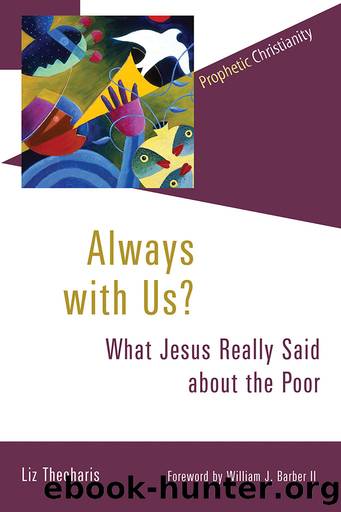Always with Us? by Liz Theoharis

Author:Liz Theoharis
Language: eng
Format: epub
Publisher: Wm. B. Eerdmans Publishing Co.
1. This quotation comes from a photo from the 1968 Poor Peopleâs Campaign called for by Rev. Dr. Martin Luther King Jr. only months before his death. It was a slogan written on the canopy of various âmule trainsâ that made their way from Marks, Mississippi, to Resurrection City in Washington, DC, where thousands of poor people from across the United States gathered to demand that the nation âlift the load of poverty.â
2. Stephen J. Patterson, âDirt, Shame, and Sin in the Expendable Company of Jesus,â in Profiles of Jesus, ed. Roy Hoover (Santa Rosa, CA: Polebridge, 2002), 202â5.
3. Richard Horsley, Jesus and Empire: The Kingdom of God and the New World Disorder (Minneapolis: Fortress, 2003), 15.
4. John Dominic Crossan, Jesus: A Revolutionary Biography (San Francisco: HarÂperCollins, 2009), xii.
5. Crossan, Jesus, 25.
6. Patterson, âDirt, Shame, and Sin,â 202.
7. Patterson, âDirt, Shame, and Sin,â 205.
8. Crossan, Jesus, 94.
9. William Herzog, Prophet and Teacher: An Introduction to the Historical Jesus (Louisville: Westminster John Knox, 2005), 81.
10. Discussion of Augustus as divine son and of the birth narrative in general runs throughout these two books: John Dominic Crossan and Jonathan Reed, In Search of Paul: How Jesusâs Apostle Opposed Romeâs Empire with Godâs Kingdom (San Francisco: HarperSanFrancisco, 2004), 160; and Paul Zanker, The Power of Images in the Age of Augustus (Ann Arbor: University of Michigan Press, 1990), 35.
11. Reza Aslan, Zealot: The Life and Times of Jesus of Nazareth (New York: Random House, 2013).
12. Richard Horsley, Covenant Economics: A Biblical Vision of Justice for All (Louisville: Westminster John Knox, 2009), 149.
13. Michael Peppard, The Son of God in the Roman World: Divine Sonship in Its Social and Political Context (London: Oxford University Press, 2012), 31â85.
14. âThe dragon stood on the shore of the sea. And I saw a beast coming out of the sea. It had ten horns and seven heads, with ten crowns on its horns, and on each head a blasphemous name. The beast I saw resembled a leopard, but had feet like those of a bear and a mouth like that of a lion. The dragon gave the beast his power and his throne and great authority. One of the heads of the beast seemed to have had a fatal wound, but the fatal wound had been healed. The whole world was filled with wonder and followed the beast. People worshiped the dragon because he had given authority to the beast, and they also worshiped the beast and asked, âWho is like the beast? Who can wage war against it?ââ (Rev 13:1â4).
15. Richard Horsley and John Hanson, Bandits, Prophets, and Messiahs: Popular Movements in the Time of Jesus (Harrisburg: Trinity Press International, 1999), xiâxii.
16. K. C. Hanson and Douglas Oakman, Palestine in the Time of Jesus: Social Structures and Social Conflicts (Minneapolis: Augsburg Fortress, 2002), 5.
17. Richard A. Horsley and Neil A. Silberman, The Message and the Kingdom: How Jesus and Paul Ignited a Revolution and Transformed the Ancient World (Minneapolis: Augsburg Fortress, 2002), 5.
18. Horsley and Silberman, The Message and the Kingdom, 27.
Download
This site does not store any files on its server. We only index and link to content provided by other sites. Please contact the content providers to delete copyright contents if any and email us, we'll remove relevant links or contents immediately.
International Integration of the Brazilian Economy by Elias C. Grivoyannis(86622)
The Radium Girls by Kate Moore(11873)
Turbulence by E. J. Noyes(7901)
Nudge - Improving Decisions about Health, Wealth, and Happiness by Thaler Sunstein(7469)
The Black Swan by Nassim Nicholas Taleb(6954)
Rich Dad Poor Dad by Robert T. Kiyosaki(6324)
Pioneering Portfolio Management by David F. Swensen(6175)
Man-made Catastrophes and Risk Information Concealment by Dmitry Chernov & Didier Sornette(5883)
Zero to One by Peter Thiel(5643)
Secrecy World by Jake Bernstein(4599)
Millionaire: The Philanderer, Gambler, and Duelist Who Invented Modern Finance by Janet Gleeson(4307)
Skin in the Game by Nassim Nicholas Taleb(4128)
The Age of Surveillance Capitalism by Shoshana Zuboff(4126)
The Money Culture by Michael Lewis(4033)
Bullshit Jobs by David Graeber(4001)
Skin in the Game: Hidden Asymmetries in Daily Life by Nassim Nicholas Taleb(3873)
The Dhandho Investor by Mohnish Pabrai(3642)
The Wisdom of Finance by Mihir Desai(3612)
Blockchain Basics by Daniel Drescher(3435)
